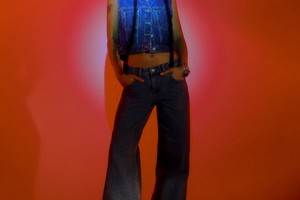NICHOLAS KIRKWOOD: ALWAYS ONE STEP FURTHER
Written by Ksenia RundinNicholas Kirkwood is always one step further, in both the boldness and originality of his innovative shoe design and the sustainable choice of materials and practices. Odalisque Magazine met the designer during Fashion Tech Talks in Stockholm, where he was one of the speakers, and had a chat with him about sustainability, co-creation, artificial intelligence, coolness, art and even music.
You started your brand in 2005, already then uniting craftsmanship with innovative design and sustainable materials. How has the sustainability aspect improved since the start? What is sustainable strategy for your company today?
Even though it has been a big change, I think, it is still right in the beginning. When I started, there was quite few in the industry, who really thought about reusable materials. My approach to sustainability is like Tesla’s, when they came about and said something like, “Why aren’t any electric cars made to look good? Why cannot an electric car be a sexy sports car?” The strategy should not be dictated by the concept, which is sustainable, it should just be given. During a couple of seasons, we are now looking at all my material lines, going all the way back. For the next season we change all our linings to become degradable and I am also looking at the similar strategy for the soles. Thus, sustainability for me is a kind of natural regression, considering all the material innovations during last three years. My intention is not to use sustainability as a marketing angle, but to apply it as a part of the process.
You and Farfetch are doing a project together with an element of co-creation integrated. Do you plan to educate your consumers in the matters of sustainability through that co-creation process?
Partly from the next-next season – Spring/Summer 2020 – and the following season, we are looking at the labelling system, which is similar to one you can see at a supermarket. We are trying to make the consumer understand how the information given to him/her at the point of purchase makes an impact on the latter and the degree of certain impact. Nevertheless, it is a long way to go but we are doing our best. There is an element of transparency in that concept and if we are honest about what we sell, it will strengthen the consumer trust.
How does artificial intelligence (AI) challenge your creating process?
To be honest, we are not using that much of AI in our creative process right now. My current roll in the company is a merchandiser and we work with merchandisers, where there is always a kind of love-hate relationship with them. Generally, designers want to think outside the box, while merchandisers look at the data, deciding what price to set, etc. I do not think AI affects design process as such, where you are both following a trend and creating a trend.
Do you think the notion of luxury will change due to the presence of AI?
There is the design process and the manufacturing. I am still making my shoes manually today, using the fine craft. However, it is also important for me to combine my products with new technologies such as 3D printing and new materials, using the best of both worlds. It is about a combination, while choosing either the one or the other does not feel right for me.
It is said that through your studies, you became aware of the ‘excitement of a movement’ as well as artists embracing ‘a coolness in their manufactured edge’. What is coolness for you today, when the subcultures seem to have erased any borders among them?
I am always blending multiple references, sometimes a reference might be for a silhouette or a fabrication. Sometimes, I mix youth subculture with architecture, with technology with how a certain music piece makes me feel. Thus, it is about multiple references and how you put those into a mix and it comes out something that looks different, looks original and not too direct as a reference. You do not merely use a punk rocker as a reference to make punk rock shoes. But you mix punk rocker with Zaha Hadid and then you get something different. This is my approach to design.
By providing access to different information, AI makes brands vulnerable for counterfeiting. How do you protect your brand equity in such a case?
It is a bit of a constant battle. If you put your design out there, it might directly become reinterpreted or directly copied. I try to be faster, one step further with my design in order to keep others one step behind.
What do you prefer, the Bloomsbury Group before the Bauhaus school or the Bauhaus school before the Bloomsbury Group?
I like Bauhaus - the movement and Bauhaus – the band. The Bauhaus school was a massive revolution. It was something that all the 20th Century architecture is related to, in one way or another. It is Modernism, Postmodernism. Potentially, it can go slightly further back and forth in little bit of arts and crafts. The Bauhaus school made the most bold and vivid design and the music is kind of colouring into that in such an extraordinary way.












